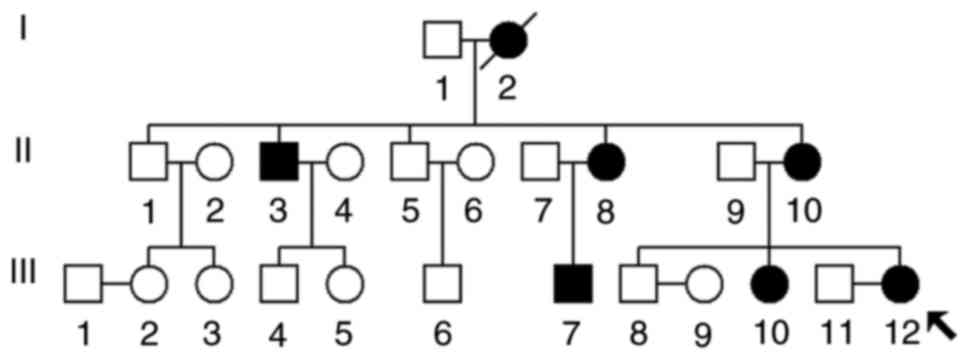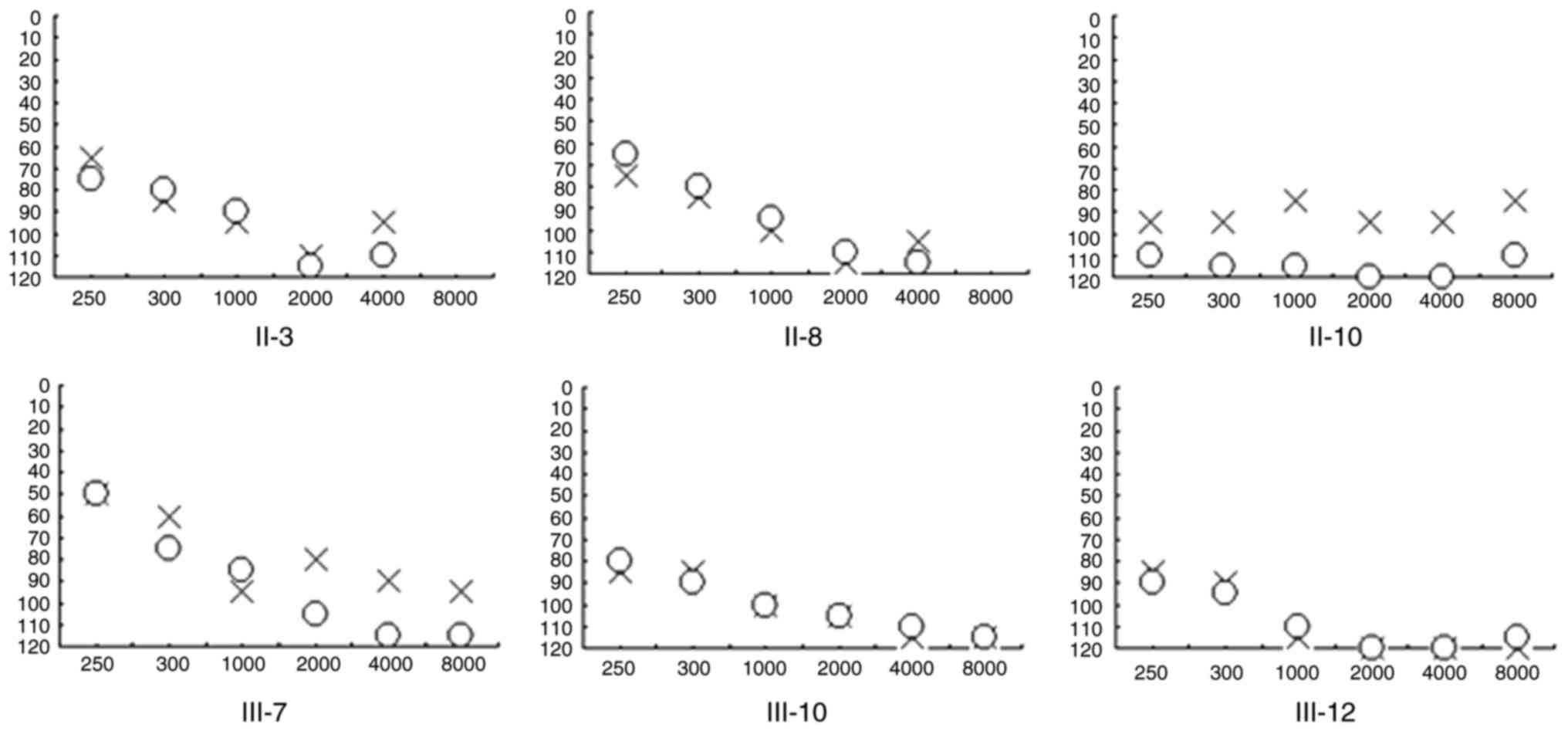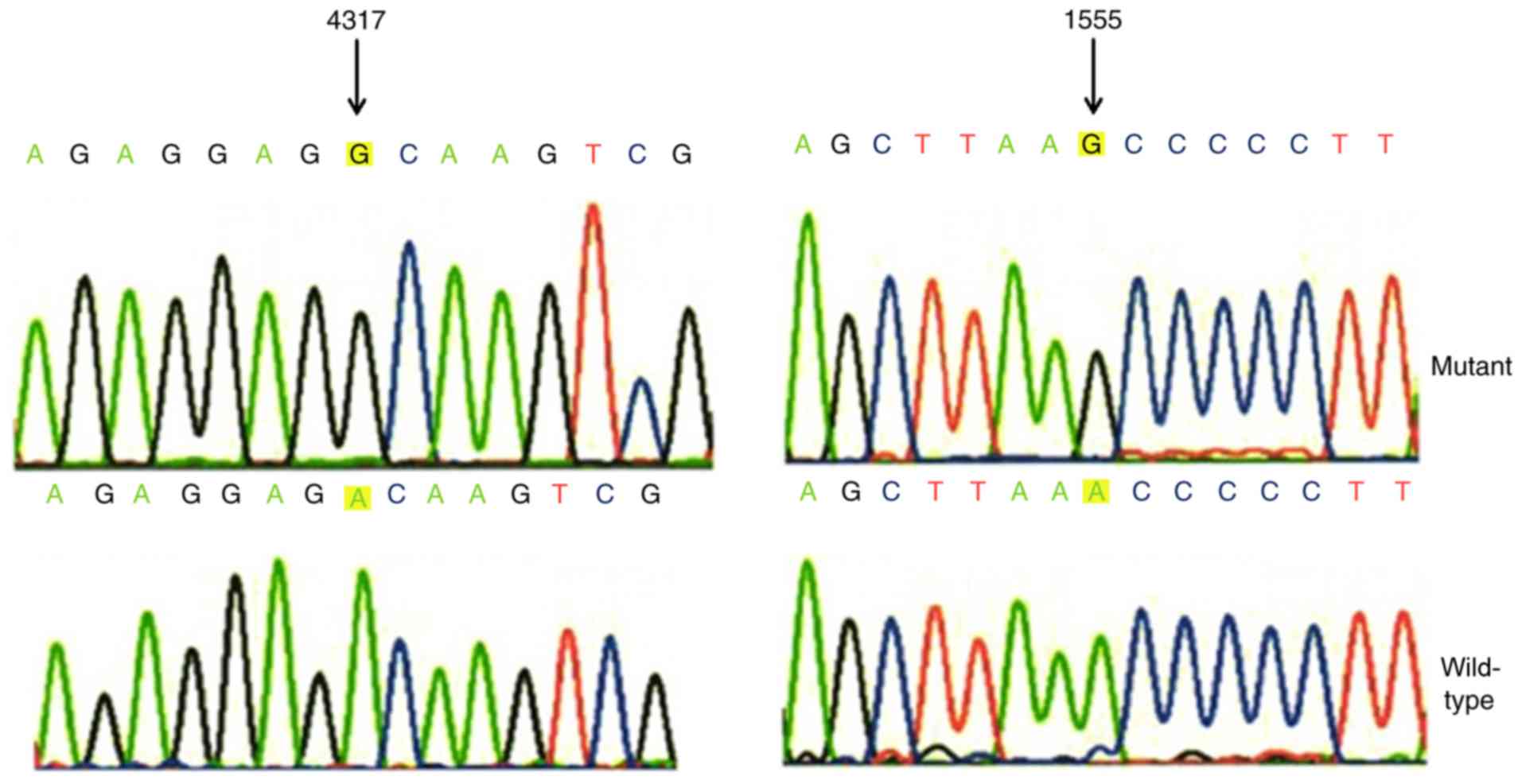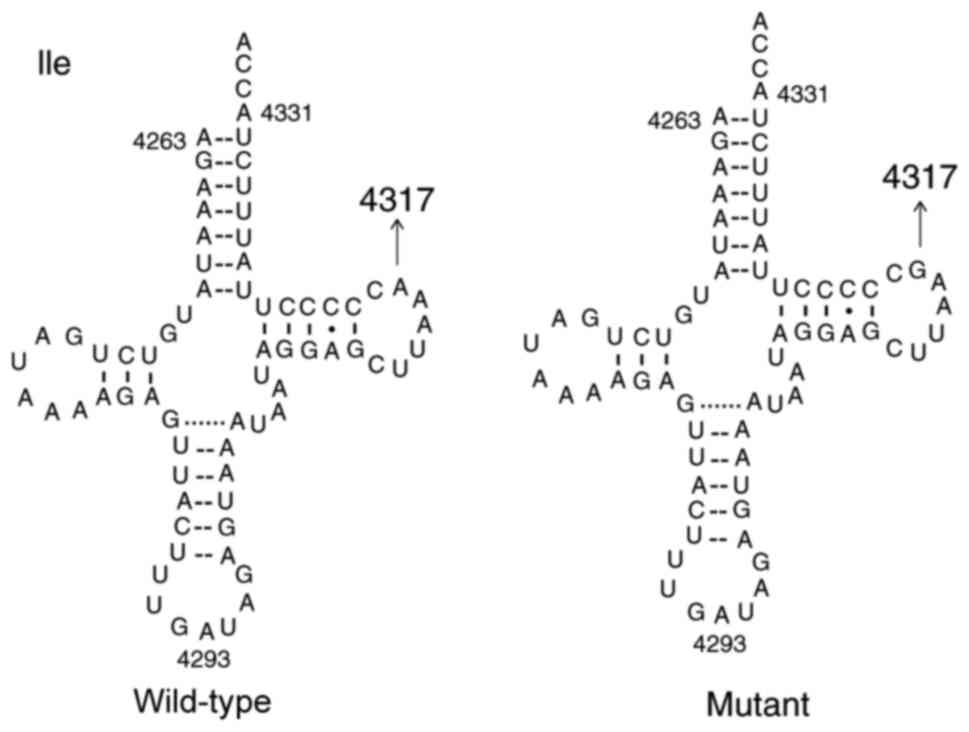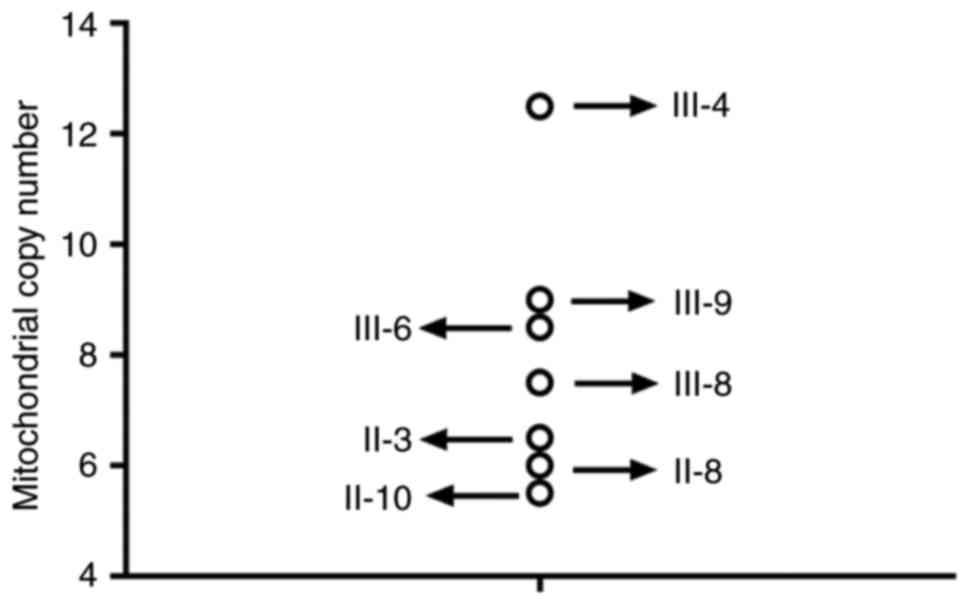Mitochondrial tRNAIle A4317G mutation may be associated with hearing impairment in a Han Chinese family
- Authors:
- Published online on: September 27, 2018 https://doi.org/10.3892/mmr.2018.9519
- Pages: 5159-5165
Abstract
Introduction
Deafness is one of the most common human health problems, affecting one in 700–1,000 newborns (1). It has been estimated that ≥50% of cases of congenital deafness have genetic causes. At present, the etiology of hearing loss remains largely unknown, although gene alterations (2–15) and environmental factors, including aminoglycoside antibiotics (AmAn), are now generally considered to be involved in this condition (16). AmAn, including gentamicin and kanamycin, are of great clinical importance for the treatment of bacterial infections. However, the use of these drugs is frequently associated with toxicity, involving the renal, auditory and vestibular systems (17). In familial cases of ototoxicity, AmAn hypersensitivity is frequently maternally transmitted, suggesting that mutations in mitochondrial (mt)DNA may be the molecular basis for this susceptibility (18). Among the mtDNA genes, 12S ribosomal (r)RNA and transfer (t)RNA are hot-spots for pathogenic mutations associated with deafness (19,20). Indeed, it has been reported that deafness-associated mtDNA primary mutations impair mitochondrial translation, leading to deficient respiration (21). However, only mild mitochondrial dysfunctions are observed in cells carrying these mtDNA mutations, suggesting that these mutations are necessary but insufficient to produce a clinical phenotype (22). Therefore, there may be other modifying factors that modulate the phenotypic manifestation of these mtDNA mutations (23).
To investigate the modifying factors that contribute to the clinical expression of deafness-associated mtDNA mutations, a mutational screening on deaf patients from Tianjin, China was performed in the present study. The present study describes a Han Chinese family with maternally-transmitted hearing loss, in which analysis of the complete mtDNA sequence demonstrated the occurrence of 12S rRNA A1555G and tRNAIle A4317G mutations. To further understand the possible role of A4317G mutation, the mtDNA copy number in the patients harboring this mutation was analyzed. In addition, to determine the contributions of the gap junction protein β2 (GJB2) and tRNA 5-methylaminomethyle-2-thiouridylate methyltransferase (TRMU) genes to the phenotypic manifestation of the A1555G mutation, a mutational analysis of these genes in individuals with hearing impairment in this family was conducted.
Patients and methods
Subjects
A screening program was performed for mtDNA mutations in deaf patients from Tianjin City, China. A Han Chinese family, as presented in Fig. 1, was enrolled in October, 2017 through the otology clinic of The PLA 254 Hospital (Tianjin, China). Informed consent was obtained from the participants prior to their participation in the study, in accordance with the requirements of the Ethics Committee of The PLA 254 Hospital. In addition, 300 healthy age- and sex-matched controls (including 100 females and 200 males; aged 20–50 years with an average of 30.5 years) were obtained from a panel of unaffected subjects with Han Chinese ancestry. The control subjects were healthy individuals, and did not have any family history of mitochondrial disorders. The present study was approved by the Ethics Committee of The PLA 254 Hospital.
Clinical examinations
A comprehensive history was taken and a physical examination was performed on all available members of this Chinese pedigree to identify any syndromic findings, history of exposure to AmAn and genetic factors associated with hearing impairment. An age-appropriate audiological examination was additionally performed, which included pure-tone audiometry (PTA), auditory brainstem response and distortion product otoacoustic emissions. The PTA was calculated from the sum of the audiometric thresholds at 500, 1,000, 2,000, 4,000 and 8,000 Hz. The severity of hearing impairment was classified into five grades: Normal (<26 dB); mild (26–40 dB); moderate (41–70) dB; severe (71–90) dB; and profound (>90 dB).
Screening for variants in the mitochondrial genome
The maternally-transmitted pattern in the studied family suggested the involvement of the mitochondria and thus analysis of variants in the mitochondrial genome was performed. Genomic DNA was isolated from whole blood samples (3 ml) from the participants using PAXgene Blood DNA Isolation kits (Qiagen, Inc., Valencia, CA, USA). The entire mitochondrial genomes of the matrilineal relatives were amplified by polymerase chain reaction (PCR) in 24 overlapping fragments using sets of the light-strand (L) and heavy-strand (H) oligonucleotide primers, as described elsewhere (24). The sequences of the primers are the same as stated in a previous study (24). The PCR primers were supplied by BGI (Shenzhen, China) and the PCR mixture included 200 µM dNTP, 10X buffer, Taq DNA polymerase and 15 mmol/l Mg2+ (Takara Biotechnology Co., Ltd., Dalian, China). The PCR was performed as follows: 95°C for 5 min, 94°C for 10 sec, 60°C for 30 sec and 72°C for 1 min (for 30 cycles), followed by 72°C extension for 5 min. Finally, 2 µl PCR product was analyzed using 1.5% agarose gel, which contained ethidium bromide, electrophoresis at 130 V for 30 min. Following electrophoresis, a BandPeeper (Maestrogen, Inc., Hsinchu, Taiwan) instrument was used to detect the results using the Invitrogen™ E-Gel™ Imager software (version 2.2.4; Invitrogen; Thermo Fisher Scientific Inc., Waltham, MA, USA). Each fragment was purified and subsequently analyzed by direct sequencing in an ABI 3700 automated DNA sequencer using the Big Dye Terminator Cycle sequencing reaction kit (Applied Biosystems; Thermo Fisher Scientific, Inc.). The resultant sequence data were compared with the updated consensus Cambridge sequence (GenBank accession no. NC_012920; www.ncbi.nlm.nih.gov/genbank) (25) and the Mitomap database (www.mitomap.org).
Phylogenetic analysis
A total of 17 vertebrate mtDNA sequences were used in the inter-species analysis. The conservation index (CI) was calculated by comparing the human nucleotide variants with 16 other vertebrates. The CI was defined as the percentage of species from the list of 16 different vertebrates that possessed the wild-type nucleotide at that position. CI ≥75% was regarded as being indicative of functional potential.
Mutational analysis of the GJB2 gene
DNA fragments spanning the entire coding region of the GJB2 gene were amplified by PCR using appropriate primers, in accordance with a previous investigation (26). The sequences of the primers are as stated in a previous study (26). PCR amplification and subsequent sequencing analysis were performed as described previously (26). The results were compared with the wild-type GJB2 sequence to identify potential mutations (GenBank accession no. M86849).
Genotyping analysis of TRMU gene
A previous study demonstrated that the TRMU exon 1 A10S mutation may modulate the phenotypic manifestation of deafness-associated mitochondrial 12S rRNA mutations (27). To determine whether TRMU serves an active role in the expression of deafness, mutational screening on TRMU exon 1 was conducted in matrilineal relatives in this pedigree and in healthy controls. The primer information and PCR conditions have been described elsewhere (27). The PCR segments were analyzed and compared with the TRMU genomic sequence (GenBank accession no. AF_448221).
mtDNA copy number analysis
The mtDNA copy number was measured using quantitative (q)PCR and the 2−ΔΔCq method (28). mtDNA content was normalized using a single copy nuclear β-globin gene. The following primers were used for qPCR analysis: β-Globin gene forward, 5′-CTATGGGACGCTTGATGT-3′ and reverse, 5′-GCAATCATTCGTCTGTTT-3′. For mtDNA forward, 5′-CACCAGCCTAACCAGATTTC-3′ and reverse, 5′-GGGTTGTATTGATGAGATTAGT-3′. Standard curves were generated for the two fragments and their respective amplification efficiencies calculated to test whether the 2−ΔΔCq method was appropriate. The 20 µl PCR reaction solution contained 2X Taqman Universal PCR Master Mix (Takara Biotechnology Co., Ltd.), 500 nmol/l of each primer, 200 nmol/l Taqman Probe and 100 ng of total DNA. PCR conditions were 2 min at 50°C and 10 min at 95°C, followed by 40 cycles of denaturation for 15 sec at 95°C and 60 sec annealing/extension at 60°C. All experiments were repeated three times.
Statistical analysis
Statistical significance was evaluated by independent Student's t-test using SPSS software version 18.0 (SPSS, Inc., Chicago, IL, USA). P<0.05 was considered to indicate a statistically significant difference.
Results
Clinical features of the Han Chinese family with hearing loss
The proband (III-12) was a 28-year-old woman from Tianjin, China. As presented in Fig. 1 and Table I, the proband began to suffer bilateral hearing loss at 1 year of age (108 dB right ear and 108 dB left ear). Subsequent to taking a comprehensive history and performing a physical examination, it was noted that the proband (III-12) had begun to use gentamycin (5 mg/kg/dose; 10 days) at the age of 15 years. Following 2 weeks of use, the proband exhibited irreversible hearing impairment. In addition, two relatives (II-3 and II-10) on the maternal side of the family had used AmAn in childhood and also developed profound hearing impairment. As presented in Fig. 2, audiological evaluation of the deaf patients in this family demonstrated that the majority of them had profound hearing loss with a slope-shaped pattern. In addition, this family exhibited a high penetrance of hearing loss, of 66.6% or 33.3% when AmAn was included or excluded, respectively.
Genotype analysis of mitochondrial genes
The fact that the deafness in this family was maternally inherited indicated that mtDNA dysfunction may be responsible for the clinical manifestation of hearing loss. The mtDNA sequence variants in matrilineal relatives in this pedigree were thus screened using PCR and direct sequencing. As presented in Table II, Sanger sequencing led to the identification of 27 genetic polymorphisms. These included 10 variants in the D-loop gene, three variants in the 12S rRNA gene, two variants in the 16S rRNA and one variant in the tRNA gene, in addition to a 9-bp common deletion in the junction between tRNALys and CO2, while other variants were primarily localized to protein-coding genes. In addition, six missense mutations were noted, including ND2 C5178A (Leu to Met), A8 C8414T (Leu to Phe), A6 A8701G (Thr to Ala) and A8860G (Thr to Ala), and CytB C14766T (Thr to Ile) and A15326G (Thr to Ala). These variants in rRNAs, tRNA and polypeptides were further evaluated by phylogenetic analysis against other organisms including mouse (29), bovine (30) and Xenopus laevis (31) sequences. However, none of these variants exhibited evolutionary conservation, with the exception of the A1555G and A4317G mutations (Figs. 3–5). In addition, A1555G and A4317G mutations were not detected in healthy subjects, which indicated that these mutations may be involved in the pathogenesis of deafness in this family (P<0.05; data is not shown).
Screening for mutations in the GJB2 gene
Mutations in the GJB2 gene have been reported to be important causes of non-syndromic hearing loss (32). Therefore, to determine the contribution of GJB2 to the expression of deafness mutational analysis of the GJB2 coding region in the matrilineal relatives and controls in this family was conducted. For this, PCR was performed, the obtained products purified, and subsequently analyzed by Sanger sequencing. However, no functional variants in the GJB2 gene were detected (data not shown).
Mutational analysis of the TRMU gene
A previous study demonstrated that TRMU acts as a nuclear modified gene and is responsible for the 2-thiolation modification of mt-tRNAs, in addition to modulating the phenotypic manifestation of deafness-associated 12S rRNA mutations (27). Therefore, the TRMU A10S mutation was screened in matrilineal relatives and controls in the family in the present study. However, no variants in TRMU exon 1 were identified.
MtDNA content analysis
As presented in Fig. 6, it was observed that the patients carrying the mitochondrial A4317G and A1555G mutations had a lower mtDNA copy number than the healthy controls, suggesting that these mutations may decrease mtDNA content and cause mitochondrial dysfunction.
Discussion
The present study reported the molecular and genetic characterizations of a Han Chinese family with maternally-transmitted and AmAn-induced hearing loss. Hearing impairment as the sole clinical phenotype was presented only in the maternal lineage of this pedigree. This family exhibited high penetrance and expressivity of deafness; in particular, the penetrance of hearing loss was 66.6% when the effect of AmAn was included and 33.3% when it was excluded. In addition, the age at onset of deafness ranged between 1 and 58 years, with an average of 35 years and the matrilineal relatives in this family had an earlier age at onset of hearing loss, suggesting that mitochondrial sequence variants may be risk factors that may be used for early molecular diagnosis and prevention of deafness.
Mutational analysis of the complete mitochondrial genome demonstrated the presence of the A1555G mutation, together with a set of genetic polymorphisms belonging to the human mitochondrial haplogroup B4c1b2 (33). The well-known A1555G mutation, which was first described in a large Arab-Israel pedigree with hearing loss (34), has been associated with AmAn-induced and non-syndromic hearing loss in numerous families worldwide (35–37). Although biochemical data indicated that the A1555G mutation led to sensitivity to AmAn (21,22), the incomplete penetrance and mild mitochondrial dysfunction suggested that this mutation alone was insufficient to produce the clinical phenotype. Therefore, other modifying factors, including environmental factors, the use of AmAn, mitochondrial variants/haplogroups and nuclear genes, may contribute to the expression of deafness. Notably, the absence of any functional variants in nuclear genes (GJB2 and TRMU) suggested that these genes may not serve important roles in the phenotypic expression of the A1555G mutation in this family; therefore, other nuclear genes may contribute to the phenotypic variability.
The mitochondrial haplogroup has been demonstrated to modulate the phenotypic expression of the deafness-associated A1555G mutation (23). For example, the haplogroup Y2 specific tRNAGlu A14693G variant may increase the penetrance and expressivity of the deafness-associated A1555G mutation (23). In the present study, sequence analysis of the complete mitochondrial genomes of the affected individuals in this family identified the occurrence of the A4317G mutation. This mutation was localized at the TΨC arm of the tRNAIle gene (position 59) using the Mitomap database, which is highly conserved from bacteria to human mitochondria (38,39). Notably, the A4317G mutation creates a novel base-pairing and may exert a structural effect. In fact, the presence of G59 facilitates the formation of an additional base pair with C54. This may in turn lead to complete rearrangement of the T stem and shortening of the T loop (40,41). Furthermore, this mutation has been reported to be associated with essential hypertension in the Han Chinese population (42). Biochemical analysis has also demonstrated that the A4317G mutation decreases the aminoacylation ability of tRNAIle (43). In addition, it was identified that this mutation significantly decreased the mtDNA copy number when compared with that in controls. Indeed, mtDNA content has been shown to be a measure indicative of the cell number or mass of mitochondria (44). A previous experimental study suggested that alterations in mtDNA serve a fundamental role in the increase in reactive oxygen species; maintenance of mtDNA copy number was demonstrated to be essential for the preservation of mitochondrial function and cell growth (45). Therefore, it may be speculated that A4317G mutation may lead to the failure of tRNA metabolism, and subsequently impair mitochondrial protein synthesis, thereby worsening mitochondrial dysfunction (represented by a malfunction in biochemical processes, characterized by mitochondrial membrane potential collapse and decreased ATP production, which also has an essential role in the mediation of apoptosis) induced by A1555G mutation (46). Therefore, the tRNAIle A4317G mutation may contribute to the high penetrance and expressivity of the hearing loss associated with the mtDNA A1555G mutation in this Chinese pedigree. The principal limitation of the present study study was the small sample size; further studies are required, with a greater number of deaf patients and controls.
Acknowledgements
Not applicable.
Funding
No funding was received.
Availability of data and materials
The datasets used and/or analyzed during the current study are available from the corresponding author on reasonable request.
Authors' contributions
YC and D-JH designed the study. YC performed the experiments and analyzed the data. D-JH wrote the paper. All authors read and approved the final version of the manuscript.
Ethics approval and consent to participate
Informed consent was obtained from the participants prior to their participation in the present study, in accordance with the Ethics Committee of PLA 254 Hospital.
Patient consent for publication
Not applicable.
Competing interests
The authors declare that they have no competing interests.
References
|
Lin X, Teng Y, Lan J, He B, Sun H and Xu F: GRHL2 genetic polymorphisms may confer a protective effect against sudden sensorineural hearing loss. Mol Med Rep. 13:2857–2863. 2016. View Article : Google Scholar : PubMed/NCBI | |
|
Nikopoulos K, Farinelli P, Giangreco B, Tsika C, Royer-Bertrand B, Mbefo MK, Bedoni N, Kjellström U, El Zaoui I, Di Gioia SA, et al: Mutations in CEP78 cause cone-rod dystrophy and hearing loss associated with primary-cilia defects. Am J Hum Genet. 99:770–776. 2016. View Article : Google Scholar : PubMed/NCBI | |
|
Namburi P, Ratnapriya R, Khateb S, Lazar CH, Kinarty Y, Obolensky A, Erdinest I, Marks-Ohana D, Pras E, Ben-Yosef T, et al: Bi-allelic truncating mutations in CEP78, encoding centrosomal protein 78, cause cone-rod degeneration with sensorineural hearing loss. Am J Hum Genet. 99:777–784. 2016. View Article : Google Scholar : PubMed/NCBI | |
|
Franzè A, Esposito G, Di Domenico C, Iossa S, Sauchelli G, Fioretti T, Cavaliere M, Auletta G, Corvino V, Laria C, et al: SLC26A4 genotypes associated with enlarged vestibular aqueduct malformation in south Italian children with sensorineural hearing loss. Clin Chem Lab Med. 54:e259–e263. 2016.PubMed/NCBI | |
|
Bakhchane A, Bousfiha A, Charoute H, Salime S, Detsouli M, Snoussi K, Nadifi S, Kabine M, Rouba H, Dehbi H, et al: Update of the spectrum of GJB2 gene mutations in 152 Moroccan families with autosomal recessive nonsyndromic hearing loss. Eur J Med Genet. 59:325–329. 2016. View Article : Google Scholar : PubMed/NCBI | |
|
Kim SJ, Lee S, Park HJ, Kang TH, Sagong B, Baek JI, Oh SK, Choi JY, Lee KY and Kim UK: Genetic association of MYH genes with hereditary hearing loss in Korea. Gene. 591:177–182. 2016. View Article : Google Scholar : PubMed/NCBI | |
|
Guan J, Wang D, Cao W, Zhao Y, Du R, Yuan H, Liu Q, Lan L, Zong L, Yang J, et al: SIX2 haploinsufficiency causes conductive hearing loss with ptosis in humans. J Hum Genet. 61:917–922. 2016. View Article : Google Scholar : PubMed/NCBI | |
|
Zhu GJ, Shi LS, Zhou H, Yang Y, Chen J and Gao X: A novel compound heterozygous mutation of SLC26A4 in two Chinese families with nonsyndromic hearing loss and enlarged vestibular aqueducts. Mol Med Rep. 16:9011–9016. 2017. View Article : Google Scholar : PubMed/NCBI | |
|
Wong SH, Wang WH, Chen PH, Li SY and Yang JJ: Functional analysis of a nonsyndromic hearing loss-associated mutation in the transmembrane II domain of the GJC3 gene. Int J Med Sci. 14:246–256. 2017. View Article : Google Scholar : PubMed/NCBI | |
|
Xia W, Hu J, Liu F, Ma J, Sun S, Zhang J, Jin K, Huang J, Jiang N, Wang X, et al: New role of LRP5, associated with nonsyndromic autosomal-recessive hereditary hearing loss. Hum Mutat. 38:1421–1431. 2017. View Article : Google Scholar : PubMed/NCBI | |
|
Lee KY, Choi SY, Bae JW, Kim S, Chung KW, Drayna D, Kim UK and Lee SH: Molecular analysis of the GJB2, GJB6 and SLC26A4 genes in Korean deafness patients. Int J Pediatr Otorhinolaryngol. 72:1301–1309. 2008. View Article : Google Scholar : PubMed/NCBI | |
|
Zhou XL, He LX, Yu LJ, Wang Y, Wang XJ, Wang ED and Yang T: Mutations in KARS cause early-onset hearing loss and leukoencephalopathy: Potential pathogenic mechanism. Hum Mutat. 38:1740–1750. 2017. View Article : Google Scholar : PubMed/NCBI | |
|
Cai XZ, Li Y, Xia L, Peng Y, He CF, Jiang L, Feng Y, Xia K, Liu XZ, Mei LY and Hu ZM: Exome sequencing identifies POU4F3 as the causative gene for a large chinese family with non-syndromic hearing loss. J Hum Genet. 62:317–320. 2017. View Article : Google Scholar : PubMed/NCBI | |
|
Palombo F, Al-Wardy N, Ruscone GA, Oppo M, Kindi MN, Angius A, Al Lamki K, Girotto G, Giangregorio T, Benelli M, et al: A novel founder MYO15a frameshift duplication is the major cause of genetic hearing loss in oman. J Hum Genet. 62:259–264. 2017. View Article : Google Scholar : PubMed/NCBI | |
|
Ryu N, Lee S, Park HJ, Lee B, Kwon TJ, Bok J, Park CI, Lee KY, Baek JI and Kim UK: Identification of a novel splicing mutation within SLC17A8 in a Korean family with hearing loss by whole-exome sequencing. Gene. 627:233–238. 2017. View Article : Google Scholar : PubMed/NCBI | |
|
Li D, Sun J, Zhao L, Guo W, Sun W and Yang S: Aminoglycoside increases permeability of osseous spiral laminae of cochlea by interrupting MMP-2 and MMP-9 balance. Neurotox Res. 31:348–357. 2017. View Article : Google Scholar : PubMed/NCBI | |
|
Sagwa EL, Souverein PC, Ribeiro I, Leufkens HG and Mantel-Teeuwisse AK: Differences in VigiBase® reporting of aminoglycoside and capreomycin-suspected ototoxicity during tuberculosis treatment. Pharmacoepidemiol Drug Saf. 26:1–8. 2017. View Article : Google Scholar : PubMed/NCBI | |
|
Ding Y, Leng J, Fan F, Xia B and Xu P: The role of mitochondrial DNA mutations in hearing loss. Biochem Genet. 51:588–602. 2013. View Article : Google Scholar : PubMed/NCBI | |
|
Li Z, Li R, Chen J, Liao Z, Zhu Y, Qian Y, Xiong S, Heman-Ackah S, Wu J, Choo DI and Guan MX: Mutational analysis of the mitochondrial 12S rRNA gene in Chinese pediatric subjects with aminoglycoside-induced and non-syndromic hearing loss. Hum Genet. 117:9–15. 2005. View Article : Google Scholar : PubMed/NCBI | |
|
Zheng J, Ji Y and Guan MX: Mitochondrial tRNA mutations associated with deafness. Mitochondrion. 12:406–413. 2012. View Article : Google Scholar : PubMed/NCBI | |
|
Guan MX, Fischel-Ghodsian N and Attardi G: A biochemical basis for the inherited susceptibility to aminoglycoside ototoxicity. Hum Mol Genet. 9:1787–1793. 2000. View Article : Google Scholar : PubMed/NCBI | |
|
Guan MX, Fischel-Ghodsian N and Attardi G: Biochemical evidence for nuclear gene involvement in phenotype of non-syndromic deafness associated with mitochondrial 12S rRNA mutation. Hum Mol Genet. 5:963–971. 1996. View Article : Google Scholar : PubMed/NCBI | |
|
Lu J, Qian Y, Li Z, Yang A, Zhu Y, Li R, Yang L, Tang X, Chen B, Ding Y, et al: Mitochondrial haplotypes may modulate the phenotypic manifestation of the deafness-associated 12S rRNA 1555A>G mutation. Mitochondrion. 10:69–81. 2010. View Article : Google Scholar : PubMed/NCBI | |
|
Rieder MJ, Taylor SL, Tobe VO and Nickerson DA: Automating the identification of DNA variations using quality-based fluorescence re-sequencing: Analysis of the human mitochondrial genome. Nucleic Acids Res. 26:967–973. 1998. View Article : Google Scholar : PubMed/NCBI | |
|
Andrews RM, Kubacka I, Chinnery PF, Lightowlers RN, Turnbull DM and Howell N: Reanalysis and revision of the cambridge reference sequence for human mitochondrial DNA. Nat Genet. 23:1471999. View Article : Google Scholar : PubMed/NCBI | |
|
Ding Y, Xia BH, Liu Q, Li MY, Huang SX and Zhuo GC: Allele-specific PCR for detecting the deafness-associated mitochondrial 12S rRNA mutations. Gene. 591:148–152. 2016. View Article : Google Scholar : PubMed/NCBI | |
|
Guan MX, Yan Q, Li X, Bykhovskaya Y, Gallo-Teran J, Hajek P, Umeda N, Zhao H, Garrido G, Mengesha, et al: Mutation in TRMU related to transfer RNA modification modulates the phenotypic expression of the deafness-associated mitochondrial 12S ribosomal RNA mutations. Am J Hum Genet. 79:291–302. 2006. View Article : Google Scholar : PubMed/NCBI | |
|
Schmittgen TD, Zakrajsek BA, Mills AG, Gorn V, Singer MJ and Reed MW: Quantitative reverse transcription-polymerase chain reaction to study mRNA decay: Comparison of endpoint and real-time methods. Anal Biochem. 285:194–204. 2000. View Article : Google Scholar : PubMed/NCBI | |
|
Bibb MJ, Van Etten RA, Wright CT, Walberg MW and Clayton DA: Sequence and gene organization of mouse mitochondrial DNA. Cell. 26:167–180. 1981. View Article : Google Scholar : PubMed/NCBI | |
|
Gadaleta G, Pepe G, De Candia G, Quagliariello C, Sbisà E and Saccone C: The complete nucleotide sequence of the Rattus norvegicus mitochondrial genome: Cryptic signals revealed by comparative analysis between vertebrates. J Mol Evol. 28:497–516. 1989. View Article : Google Scholar : PubMed/NCBI | |
|
Roe BA, Ma DP, Wilson R and Wong JF: The complete nucleotide sequence of the xenopus laevis mitochondrial genome. J Biol Chem. 260:9759–9774. 1985.PubMed/NCBI | |
|
Dai ZY, Sun BC, Huang SS, Yuan YY, Zhu YH, Su Y and Dai P: Correlation analysis of phenotype and genotype of GJB2 in patients with non-syndromic hearing loss in china. Gene. 570:272–276. 2015. View Article : Google Scholar : PubMed/NCBI | |
|
Kong QP, Bandelt HJ, Sun C, Yao YG, Salas A, Achilli A, Wang CY, Zhong L, Zhu CL, Wu SF, et al: Updating the East Asian mtDNA phylogeny: A prerequisite for the identification of pathogenic mutations. Hum Mol Genet. 15:2076–2086. 2006. View Article : Google Scholar : PubMed/NCBI | |
|
Prezant TR, Agapian JV, Bohlman MC, Bu X, Oztas S, Qiu WQ, Arnos KS, Cortopassi GA, Jaber L and Rotter JI: Mitochondrial ribosomal RNA mutation associated with both antibiotic-induced and non-syndromic deafness. Nat Genet. 4:289–294. 1993. View Article : Google Scholar : PubMed/NCBI | |
|
el-Schahawi M, de Munain López A, Sarrazin AM, Shanske AL, Basirico M, Shanske S and DiMauro S: Two large Spanish pedigrees with nonsyndromic sensorineural deafness and the mtDNA mutation at nt 1555 in the 12s rRNA gene: Evidence of heteroplasmy. Neurology. 48:453–456. 1997. View Article : Google Scholar : PubMed/NCBI | |
|
Yuan EF, Xia W, Huang JT, Hu L, Liao X, Dai X and Liu SM: A sensitive and convenient method for clinical detection of non-syndromic hearing loss-associated common mutations. Gene. 628:322–328. 2017. View Article : Google Scholar : PubMed/NCBI | |
|
Lu J, Li Z, Zhu Y, Yang A, Li R, Zheng J, Cai Q, Peng G, Zheng W, Tang X, et al: Mitochondrial 12S rRNA variants in 1642 han chinese pediatric subjects with aminoglycoside-induced and nonsyndromic hearing loss. Mitochondrion. 10:380–390. 2010. View Article : Google Scholar : PubMed/NCBI | |
|
Suzuki T and Nagao A: Human mitochondrial tRNAs: Biogenesis, function, structural aspects, and diseases. Annu Rev Genet. 45:299–329. 2011. View Article : Google Scholar : PubMed/NCBI | |
|
Pütz J, Giegé R and Florentz C: Diversity and similarity in the tRNA world: Overall view and case study on malaria-related tRNAs. FEBS Lett. 584:350–358. 2010. View Article : Google Scholar : PubMed/NCBI | |
|
Tanaka M, Ino H, Ohno K, Hattori K, Sato W, Ozawa T, Tanaka T and Itoyama S: Mitochondrial mutation in fatal infantile cardiomyopathy. Lancet. 336:14521990. View Article : Google Scholar : PubMed/NCBI | |
|
Lechowicz U, Pollak A, Frączak A, Rydzanicz M, Stawiński P, Lorens A, Skarżyński PH, Skarżyński H, Płoski R and Ołdak M: Application of next-generation sequencing to identify mitochondrial mutations: Study on m.7511T>C in patients with hearing loss. Mol Med Rep. 17:1782–1790. 2018.PubMed/NCBI | |
|
Zhu HY, Wang SW, Liu L, Chen R, Wang L, Gong XL and Zhang ML: Genetic variants in mitochondrial tRNA genes are associated with essential hypertension in a chinese Han population. Clin Chim Acta. 410:64–69. 2009. View Article : Google Scholar : PubMed/NCBI | |
|
Degoul F, Brule H, Cepanec C, Helm M, Marsac C, Leroux J, Giegé R and Florentz C: Isoleucylation properties of native human mitochondrial tRNAIle and tRNAIle transcripts. Implications for cardiomyopathy-related point mutations (4269, 4317) in the tRNAIle gene. Hum Mol Genet. 7:347–354. 1998. View Article : Google Scholar : PubMed/NCBI | |
|
Ding Y, Zhuo G and Zhang C: The mitochondrial tRNALeu(UUR) A3302G mutation may be associated with insulin resistance in woman with polycystic ovary syndrome. Reprod Sci. 23:228–233. 2016. View Article : Google Scholar : PubMed/NCBI | |
|
Jeng JY, Yeh TS, Lee JW, Lin SH, Fong TH and Hsieh RH: Maintenance of mitochondrial DNA copy number and expression are essential for preservation of mitochondrial function and cell growth. J Cell Biochem. 103:347–357. 2008. View Article : Google Scholar : PubMed/NCBI | |
|
Shibata SB, Ranum PT, Moteki H, Pan B, Goodwin AT, Goodman SS, Abbas PJ, Holt JR and Smith RJH: RNA interference prevents autosomal-dominant hearing loss. Am J Hum Genet. 98:1101–1113. 2016. View Article : Google Scholar : PubMed/NCBI |



